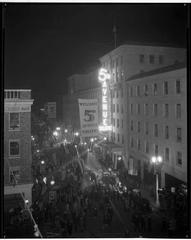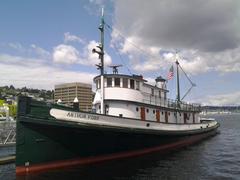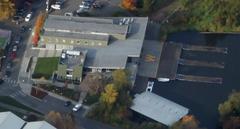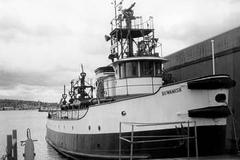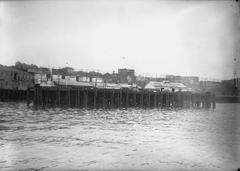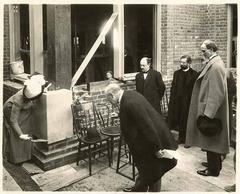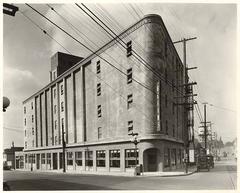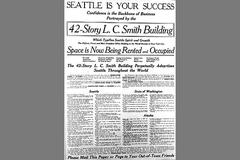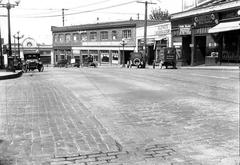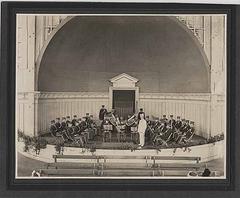Magnuson Park Visiting Hours, Tickets, and Seattle Historical Sites Guide
Date: 04/07/2025
Introduction
Magnuson Park, located on Seattle’s scenic Sand Point peninsula along the shores of Lake Washington, stands as a testament to the city’s transformation from military innovation hub to urban oasis. Spanning over 350 acres, it is Seattle’s second-largest city park, blending preserved heritage, ecological restoration, and vibrant community life. Once the Sand Point Naval Air Station—a focal point for pioneering aviation and vital wartime operations—Magnuson Park is now a multifaceted destination for history enthusiasts, outdoor adventurers, families, and cultural explorers. This guide provides comprehensive information on visiting hours, ticketing, historical significance, accessibility, key attractions, travel tips, and ongoing community and environmental initiatives. For the most current updates and detailed resources, see the official Seattle Parks website and the Seattle Parks Governance Analysis, 2025.
Table of Contents
- Discover Magnuson Park: Seattle’s Historic Gem and Urban Oasis
- Early Origins and Military Significance
- Postwar Evolution and Park Development
- Preserving Historic Structures
- Visiting Hours, Accessibility, and Tickets
- Park Attractions and Activities
- Travel Tips & Nearby Sights
- Community Engagement & Equity Initiatives
- Heritage, Art & Modern Amenities
- Environmental Stewardship & Education
- Ongoing Challenges & Future Vision
- Frequently Asked Questions (FAQ)
- Additional Resources
Discover Magnuson Park: Seattle’s Historic Gem and Urban Oasis
Nestled on the picturesque Sand Point peninsula, Magnuson Park welcomes visitors to a unique blend of historic legacy, community spaces, and natural beauty. Here, you’ll find everything from preserved naval buildings and public art to sports fields, wetlands, and accessible trails. Whether you’re a history buff, a nature lover, or simply looking for a family-friendly retreat, Magnuson Park offers a memorable Seattle experience.
Early Origins and Military Significance
Magnuson Park occupies land with deep roots in aviation and military history. Selected in the early 20th century as Seattle’s first municipal airport, Sand Point gained national recognition as the launch and landing site for the world’s first successful aerial circumnavigation in 1924—a feat commemorated by the World Flight Monument at the park’s N.E. 74th Street entrance (Seattle Parks). By the 1920s, the U.S. Navy established the Sand Point Naval Air Station, which became a key operational hub during World War II, serving as the 13th Naval District headquarters and supporting both military and early Boeing aviation operations (HistoryLink; Wikipedia). The site’s military importance continued through the Cold War, with many original structures still standing today.
Postwar Evolution and Park Development
After World War II, Sand Point Naval Air Station’s military role slowly waned, and the base was officially decommissioned in 1970. Community debate followed, with residents ultimately advocating for conversion to public parkland. U.S. Senator Warren G. Magnuson was instrumental in transferring surplus property to the City of Seattle, resulting in the formal dedication of the park in 1977 (HistoryLink; Seattle Parks). Subsequent master planning and land transfers in the 1990s and 2000s shaped the park’s recreational and ecological focus.
Preserving Historic Structures
Magnuson Park’s Historic District conserves more than 20 brick and metal military-era buildings, many with distinctive Art Deco and early 20th-century architecture. The Sand Point Naval Barracks and Building 18 (the old firehouse) are designated historic landmarks, with ongoing preservation and adaptive reuse projects led by organizations like Historic Seattle (Historic Seattle Blog; Vacation Washington State). Repurposed hangars, barracks, and offices now serve as community centers, artist studios, and event venues.
Visiting Hours, Accessibility, and Tickets
- Park Hours: Open daily, typically 5:00 AM–11:00 PM (some sources list 4:00 AM–11:30 PM; check Seattle Parks for updates).
- Admission: Free for all visitors; no tickets required for general access.
- Parking: Multiple free lots throughout the park; can fill up during peak times.
- Accessibility: ADA-compliant restrooms, paved trails, accessible parking, and inclusive playgrounds ensure a welcoming experience for visitors with disabilities.
- Public Transit: King County Metro buses serve both main entrances on Sand Point Way NE; easy access via the Burke-Gilman Trail for cyclists and pedestrians.
- Facility Use: Some amenities (e.g., Arena Sports, tennis courts, guided tours) may require reservations or fees; see community center page for details.
Park Attractions and Activities
Nature & Exploration
- Wetlands & Wildlife: Over 74 acres of restored wetlands support birdwatching (200+ species recorded), nature walks, and ecological education (citybop.com).
- Trails: Paved and unpaved routes for walking, biking, and running; easy access to the Burke-Gilman Trail.
- Lake Washington Shoreline: Swimming beach (lifeguarded in summer), boat launch, and water access for kayaking, canoeing, paddleboarding, and sailing.
Recreation & Sports
- Sports Fields: Soccer, baseball, rugby, and cricket fields; tennis courts; Arena Sports indoor facility.
- Off-Leash Dog Area: Seattle’s largest, with 6.8–8.6 fenced acres and direct lake access (seattlesecrets.org).
- Playgrounds: Inclusive play structures, basketball hoops, and nature play zones.
- Picnicking: Reservable shelters and open areas; barbecues permitted in designated zones.
Art & Culture
- Public Art: “Fin Project: From Swords into Plowshares” (submarine fins); World Flight Monument; other installations reflect scientific and aviation heritage (mypacer.com).
- Community Spaces: Magnuson Park Gallery, Seattle Musical Theatre, and ongoing cultural programming.
Events & Programs
- Community Events: Outdoor concerts, movies, festivals, and runs (Magnuson Series); children’s camps and environmental workshops.
- Guided Tours: Occasional historic and ecological tours—check Seattle Parks events for schedules.
Travel Tips & Nearby Sights
- Best Times to Visit: Spring and summer for wildlife, gardens, and outdoor events. Weekdays offer quieter experiences.
- Nearby Attractions: University of Washington campus, Burke Museum, and Lake Washington waterfront parks.
- Food & Refreshments: Magnuson Café & Brewery (local fare and lake views); food trucks during events.
- Getting Around: Download the park map (PDF) for navigation.
Community Engagement & Equity Initiatives
Magnuson Park’s evolution reflects strong community advocacy, prioritizing access for all. Development plans have incorporated input from over 1,000 residents, emphasizing equitable programming for people of color, immigrants, refugees, and low-income families (Seattle Parks Governance Analysis, 2025, p. 43). Affordable housing and social services coexist with recreational amenities, delivered by organizations like Mercy Housing and Solid Ground.
Heritage, Art & Modern Amenities
Magnuson Park deftly integrates its military past with eco-friendly redevelopment. Art installations repurpose surplus submarine parts and aviation motifs, while historic structures support community events and cultural organizations (Secret Attractions; Historic Seattle Blog). Modern facilities, inclusive playgrounds, and environmental education programs foster a lively, dynamic park atmosphere.
Environmental Stewardship & Education
- Wetlands Restoration: Extensive ecological projects have transformed former military grounds into vibrant habitats, improving water quality and supporting native flora and fauna.
- Volunteer & Education Programs: Groups like Magnuson Environmental Stewardship Alliance and Beavers Northwest offer opportunities for learning and community involvement (Seattle Parks Governance Analysis, 2025, p. 17).
- Interpretive Signage & Walks: Self-guided and periodic guided tours enrich visitor understanding of ecosystem health and sustainability.
Ongoing Challenges & Future Vision
- Historic Preservation: Many original buildings require repair and adaptive reuse to ensure safety and access for future generations (Historic Seattle Blog).
- Management Complexity: Federal land transfer terms and historic designations necessitate ongoing coordination among city agencies, nonprofits, and the community (Seattle Parks Governance Analysis, 2025, p. 17).
- Community Vision: Magnuson Park’s future as a premier recreational, cultural, and ecological asset remains a shared community goal (Seattle Parks Governance Analysis, 2025, p. 43).
Frequently Asked Questions (FAQ)
Q: What are Magnuson Park’s visiting hours?
A: Open daily, typically 5:00 AM–11:00 PM (some sources list 4:00 AM–11:30 PM).
Q: Is there an entrance fee?
A: No, general entry is free. Some facilities or events may have fees.
Q: Are dogs allowed, and is there an off-leash area?
A: Yes, Magnuson Park has Seattle’s largest fenced off-leash dog area with lake access.
Q: How accessible is the park?
A: Paved, ADA-compliant trails, restrooms, and playgrounds support visitors with disabilities.
Q: Are public transit and cycling options available?
A: Yes, King County Metro buses serve the park; cyclists can use the Burke-Gilman Trail.
Q: Can I rent boats or equipment?
A: Public boat launch available; rentals typically offered by third-party vendors.
Additional Resources
- Seattle Parks & Recreation: Magnuson Park
- Magnuson Park Map (PDF)
- Seattle Parks Governance Analysis, 2025
- ParentMap: Things to Do at Magnuson Park
- HistoryLink Essay 2287: Sand Point Naval Air Station
- Vacation Washington State: Warren G. Magnuson Park
- Secret Attractions: Seattle Hidden Parks
- My Backyard & Beyond: Magnuson Park
- Park Preview: Magnuson Park Introduction
Summary and Next Steps
Magnuson Park exemplifies Seattle’s ability to honor its heritage while embracing community needs and environmental priorities. Visitors can explore historic naval architecture, vibrant wetlands, recreation facilities, and public art, all with free admission and a commitment to accessibility. Ongoing preservation, restoration, and inclusive programming ensure Magnuson Park remains a cherished asset for generations to come.
To stay informed about special events, tours, and visitor tips, visit the Seattle Parks & Recreation Magnuson Park page and consider downloading the Audiala app for real-time updates and interactive maps.
Sources:
- Seattle Parks: Magnuson Park History
- Seattle Parks Governance Analysis, 2025
- CityBop: Magnuson Park
- Seattle Parks & Recreation: Magnuson Community Center
- HistoryLink Essay 2287: Sand Point Naval Air Station
- Historic Seattle Blog: The Future of Building 18, the Old Firehouse at Sand Point NAS Historic District
- Secret Attractions: Seattle Hidden Parks
- Vacation Washington State: Warren G. Magnuson Park
